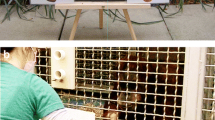Abstract
The face inversion effect may be defined as the general impairment in recognition that occurs when faces are rotated 180°. This phenomenon seems particularly strong for faces as opposed to other objects and is often used as a marker of a specialized face-processing mechanism. Four brown capuchin monkeys (Cebus apella) were tested on their ability to discriminate several classes of facial and non-facial stimuli presented in both their upright and inverted orientations in an oddity task. Results revealed significantly better performance on upright than inverted presentations of capuchin and human face stimuli, but not on chimpanzee faces or automobiles. These data support previous studies in humans and other primates suggesting that the inversion effect occurs for stimuli for which subjects have developed an expertise.




Similar content being viewed by others
References
Bruce C (1982) Face recognition by monkeys: absence of an inversion effect. Neuropsychologia 20:515–521
Bruce V, Humphreys GW (1994) Recognizing objects and faces. Visual Cognition 1(2 & 3):141–180
Carey S, Diamond R (1977) From piecemeal to configurational representation of faces. Science 195(4275):312–314
Dahl CD, Logothetis NK, Hoffman KL (2007) Individuation and holistic processing of faces in rhesus monkeys. Proc R Soc Lond B Biol Sci 274(1622):2069–2076
Diamond R, Carey S (1986) Why faces are and are not special: an effect of expertise. J Exp Psychol Gen 115(2):107–117
Dittrich W (1990) Representation of faces in longtailed macaques (Macaca fascicularis). Ethology 85:265–278
Dufour V, Pascalis O, Petit O (2006) Face processing limitation to own species in primates: a comparative study in brown capuchins, Tonkean macaques and humans. Behav Process 73(1):107–113
Farah MJ, Wilson KD, Drain HM, Tanaka JR (1995) The inverted face inversion effect in prosopagnosia: evidence for mandatory, face-specific perceptual mechanisms. Vis Res 35(14):2089–2093
Fujita K (1987) Species recognition by five macaque monkeys. Primates 28(3):353–366
Gauthier I, Bukach CM (2007) Should we reject the expertise hypothesis? Cognition 103(2):322–330
Gothard KM, Erickson CA, Amaral DG (2004) How do rhesus monkeys (Macaca mulatta) scan faces in a visual paired comparison task? Anim Cog 7:25–36
Johnston RA, Edmonds AJ (2009) Familiar and unfamiliar face recognition: a review. Memory 17(5):577–596. doi:10.1080/09658210902976969 (Hove, England)
Kendrick KM, Atkins K, Hinton MR, Heavens P, Keverne B (1996) Are faces special for sheep? Evidence from facial and object discrimination learning tests showing effects of inversion and social familiarity. Behav Proc 38:19–35
McKone E, Robbins R (2007) The evidence rejects the expertise hypothesis: reply to Gauthier and Bukach. Cognition 103(2):331–336
Neiworth JJ, Hassett JM, Sylvester CJ (2007) Face processing in humans and new world monkeys: the influence of experiential and ecological factors. Anim Cog 10(2):125–134
Overman WH, Doty RW (1982) Hemispheric specialization displayed by man but not macaques for analysis of faces. Neuropsychologia 20:113–128
Parr LA, Heintz M (2006) The perception of unfamiliar faces and houses by chimpanzees: influence of rotation angle. Perception 35:1473–1483
Parr LA, Dove T, Hopkins WD (1998) Why faces may be special: evidence of the inversion effect in chimpanzees. J Cog Neurosci 10(5):615–622
Parr LA, Winslow JT, Hopkins WD (1999) Is the inversion effect in rhesus monkeys face-specific? Anim Cog 2(3):123–129
Perrett DI, Mistlin AJ, Chitty AJ, Smith PA, Potter DD, Broennimann R, Harries M (1988) Specialized face processing and hemispheric asymmetry in man and monkey: evidence from single unit and reaction time studies. Behav Brain Res 1988(29):3
Phelps MT, Roberts WA (1994) Memory for pictures of upright and inverted faces in humans (Homo sapiens), squirrel monkey (Saimiri sciureus), and pigeons (Columba livia). J Comp Psychol 108(2):114–125
Pokorny JJ, de Waal FBM (2009a) Face recognition in capuchin monkeys (Cebus apella). J Comp Psychol 123(2):151–160
Pokorny JJ, de Waal FBM (2009b) Monkeys recognize the faces of group mates in photographs. Proc Natl Acad Sci USA 107(2):519–520
Rosenfeld SA, van Hoesen GW (1979) Face recognition in the rhesus monkey. Neuropsychologia 17:503–509
Siegel S, Castellan NJ Jr (1988) Nonparametric statistics for the behavioral sciences, 2nd edn. McGraw-Hill Inc., New York
Swartz KB (1983) Species discrimination in infant pigtail macaques with pictorial stimuli. Dev Psychobiol 16(3):219–231
Tanaka JW, Farah MJ (1991) Second-order relational properties and the inversion effect: testing a theory of face perception. Percep Psychophy 50(4):367–372
Tomonaga M (1994) How laboratory-raised Japanese monkeys (Macaca fuscata) perceive rotated photographs of monkeys: evidence for an inversion effect in face perception. Primates 35(2):155–165
Tomonaga M (1999) Inversion effect in perception of human faces in a chimpanzee (Pan troglodytes). Primates 40(3):417–438
Tomonaga M (2007) Visual search for orientation of faces by a chimpanzee (Pan troglodytes): face-specific upright superiority and the role of facial configural properties. Primates 48(1):1–12
Valentine T (1988) Upside-down faces: a review of the effect of inversion upon face recognition. Br J Psychol 79:471–491
Vermeire BA, Hamilton CR (1998) Inversion effect for faces in split-brain monkeys. Neuropsychologia 36(10):1003–1014
Weiss DJ, Kralik J, Hauser MD (2001) Face processing in cotton-top tamarins (Saguinus oedipus). Anim Cog 4:191–205
Yin RK (1969) Looking at upside-down faces. J Exp Psychol 81(1):141–145
Yin RK (1970) Face recognition by brain-injured patients: a dissociable ability? Neuropsychologia 8(4):395–402
Acknowledgments
This study was supported by grants from the National Science Foundation (IBN-0077706) to the senior author and the basegrant (RR-00165) of the National Institutes of Health to the Yerkes National Primate Research Center. We thank Kristin Leimgruber for assistance, Nancy Bliwise for statistical assistance, and the animal care and veterinary staff of the Yerkes National Primate Research Center for maintaining the health of our study subjects. The Yerkes National Primate Research Center is fully accredited by the American Association for Accreditation for Laboratory Animal Care. We also thank three anonymous reviewers for their feedback and comments.
Author information
Authors and Affiliations
Corresponding author
Additional information
An erratum to this article can be found at http://dx.doi.org/10.1007/s10071-011-0427-0
Rights and permissions
About this article
Cite this article
Pokorny, J.J., Webb, C.E. & de Waal, F.B.M. An inversion effect modified by expertise in capuchin monkeys. Anim Cogn 14, 839–846 (2011). https://doi.org/10.1007/s10071-011-0417-2
Received:
Revised:
Accepted:
Published:
Issue Date:
DOI: https://doi.org/10.1007/s10071-011-0417-2




